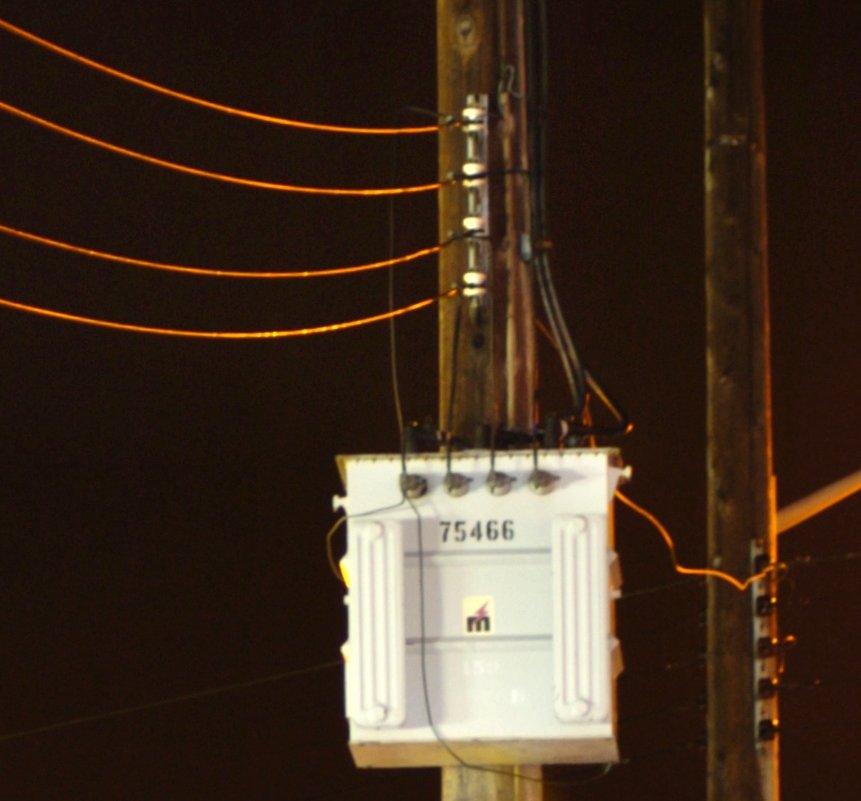|
Single-phase Electric Power
In electrical engineering, single-phase electric power (abbreviated 1φ) is the distribution of alternating current electric power using a system in which all the voltages of the supply vary in unison. Single-phase distribution is used when loads are mostly lighting and heating, with few large electric motors. A single-phase supply connected to an alternating current electric motor does not produce a rotating magnetic field; single-phase motors need additional circuits for starting (capacitor start motor), and such motors are uncommon above 10 kW in rating. Because the voltage of a single phase system reaches a peak value twice in each cycle, the instantaneous power is not constant. Standard frequencies of single-phase power systems are either 50 or 60 Hz. Special single-phase traction power networks may operate at 16.67 Hz or other frequencies to power electric railways. History Single phase power transmission took many years to develop. The earliest developments ... [...More Info...] [...Related Items...] OR: [Wikipedia] [Google] [Baidu] |
Neutral Wire
Ground and neutral are circuit conductors used in alternating current electrical systems. The ground circuit is connected to earth, and neutral circuit is usually connected to ground. As the neutral point of an electrical supply system is often connected to earth ground, ground and neutral are closely related. Under certain conditions, a conductor used to connect to a system neutral is also used for grounding (earthing) of equipment and structures. Current carried on a grounding conductor can result in objectionable or dangerous voltages appearing on equipment enclosures, so the installation of grounding conductors and neutral conductors is carefully defined in electrical regulations. Where a neutral conductor is used also to connect equipment enclosures to earth, care must be taken that the neutral conductor never rises to a high voltage with respect to local ground. Definitions Ground or earth in a mains ( AC power) electrical wiring system is a conductor that provides a low ... [...More Info...] [...Related Items...] OR: [Wikipedia] [Google] [Baidu] |
Electric Power Distribution
Electric power distribution is the final stage in the delivery of electric power; it carries electricity from the transmission system to individual consumers. Distribution substations connect to the transmission system and lower the transmission voltage to medium voltage ranging between and with the use of transformers. ''Primary'' distribution lines carry this medium voltage power to distribution transformers located near the customer's premises. Distribution transformers again lower the voltage to the utilization voltage used by lighting, industrial equipment and household appliances. Often several customers are supplied from one transformer through ''secondary'' distribution lines. Commercial and residential customers are connected to the secondary distribution lines through service drops. Customers demanding a much larger amount of power may be connected directly to the primary distribution level or the subtransmission level. The transition from transmission to distribu ... [...More Info...] [...Related Items...] OR: [Wikipedia] [Google] [Baidu] |
Three-phase Electric Power
Three-phase electric power (abbreviated 3φ) is a common type of alternating current used in electricity generation, transmission, and distribution. It is a type of polyphase system employing three wires (or four including an optional neutral return wire) and is the most common method used by electrical grids worldwide to transfer power. Three-phase electrical power was developed in the 1880s by multiple people. Three-phase power works by the voltage and currents being 120 degrees out of phase on the three wires. As an AC system it allows the voltages to be easily stepped up using transformers to high voltage for transmission, and back down for distribution, giving high efficiency. A three-wire three-phase circuit is usually more economical than an equivalent two-wire single-phase circuit at the same line to ground voltage because it uses less conductor material to transmit a given amount of electrical power. Three-phase power is mainly used directly to power large induction ... [...More Info...] [...Related Items...] OR: [Wikipedia] [Google] [Baidu] |
Two-phase Electric Power
Two-phase electrical power was an early 20th-century polyphase alternating current electric power distribution system. Two circuits were used, with voltage phases differing by one-quarter of a cycle, 90°. Usually circuits used four wires, two for each phase. Less frequently, three wires were used, with a common wire with a larger-diameter conductor. Some early two-phase generators had two complete rotor and field assemblies, with windings physically offset to provide two-phase power. The generators at Niagara Falls installed in 1895 were the largest generators in the world at that time and were two-phase machines. Three-phase systems eventually replaced the original two-phase power systems for power transmission and utilization. There remain few two-phase distribution systems, with examples in Philadelphia, Pennsylvania; many buildings in Center City are permanently wired for two-phase and Hartford, Connecticut. Comparison with single-phase power The advantage of two-phase e ... [...More Info...] [...Related Items...] OR: [Wikipedia] [Google] [Baidu] |
Single-wire Earth Return
Single-wire earth return (SWER) or single-wire ground return is a single-wire transmission line which supplies single-phase electric power from an electrical grid to remote areas at lowest cost. Its distinguishing feature is that the earth (or sometimes a body of water) is used as the return path for the current, to avoid the need for a second wire (or '' neutral wire'') to act as a return path. Single-wire earth return is principally used for rural electrification, but also finds use for larger isolated loads such as water pumps. It is also used for high-voltage direct current over submarine power cables. Electric single-phase railway traction, such as light rail, uses a very similar system. It uses resistors to earth to reduce hazards from rail voltages, but the primary return currents are through the rails. History Lloyd Mandeno, OBE (1888–1973) fully developed SWER in New Zealand around 1925 for rural electrification. Although he termed it "Earth Working Single ... [...More Info...] [...Related Items...] OR: [Wikipedia] [Google] [Baidu] |
Distribution Transformer
Single-phase distribution transformer in Canada A distribution transformer or service transformer is a transformer that provides the final voltage transformation in the electric power distribution system, stepping down the voltage used in the distribution lines to the level used by the customer. The invention of a practical efficient transformer made AC power distribution feasible; a system using distribution transformers was demonstrated as early as 1882. If mounted on a utility pole, they are called pole-mount transformers. If the distribution lines are located at ground level or underground, distribution transformers are mounted on concrete pads and locked in steel cases, thus known as distribution tap pad-mount transformers. Distribution transformers normally have ratings less than 200 kVA, although some national standards can allow for units up to 5000 kVA to be described as distribution transformers. Since distribution transformers are energized for 24 hours a day (even ... [...More Info...] [...Related Items...] OR: [Wikipedia] [Google] [Baidu] |
Single-wire Earth Return
Single-wire earth return (SWER) or single-wire ground return is a single-wire transmission line which supplies single-phase electric power from an electrical grid to remote areas at lowest cost. Its distinguishing feature is that the earth (or sometimes a body of water) is used as the return path for the current, to avoid the need for a second wire (or '' neutral wire'') to act as a return path. Single-wire earth return is principally used for rural electrification, but also finds use for larger isolated loads such as water pumps. It is also used for high-voltage direct current over submarine power cables. Electric single-phase railway traction, such as light rail, uses a very similar system. It uses resistors to earth to reduce hazards from rail voltages, but the primary return currents are through the rails. History Lloyd Mandeno, OBE (1888–1973) fully developed SWER in New Zealand around 1925 for rural electrification. Although he termed it "Earth Working Single ... [...More Info...] [...Related Items...] OR: [Wikipedia] [Google] [Baidu] |
Earthing System
An earthing system (UK and IEC) or grounding system (US) connects specific parts of an electric power system with the ground, typically the Earth's conductive surface, for safety and functional purposes. The choice of earthing system can affect the safety and electromagnetic compatibility of the installation. Regulations for earthing systems vary among countries, though most follow the recommendations of the International Electrotechnical Commission (IEC). Regulations may identify special cases for earthing in mines, in patient care areas, or in hazardous areas of industrial plants. In addition to electric power systems, other systems may require grounding for safety or function. Tall structures may have lightning rods as part of a system to protect them from lightning strikes. Telegraph lines may use the Earth as one conductor of a circuit, saving the cost of installation of a return wire over a long circuit. Radio antennas may require particular grounding for operation, ... [...More Info...] [...Related Items...] OR: [Wikipedia] [Google] [Baidu] |
Electric Shock
Electrical injury is a physiological reaction caused by electric current passing through the body. The injury depends on the density of the current, tissue resistance and duration of contact. Very small currents may be imperceptible or produce a light tingling sensation. A shock caused by low and otherwise harmless current could startle an individual and cause injury due to jerking away or falling. Stronger currents may cause some degree of discomfort or pain, while more intense currents may induce involuntary muscle contractions, preventing the person from breaking free of the source of electricity. Still larger currents result in tissue damage and may trigger ventricular fibrillation or cardiac arrest. Consequences of injury from electricity may include amputations, bone fractures and orthopedic and musculoskeletal injuries. If death results from an electric shock the cause of death is generally referred to as electrocution. Electric injury occurs upon contact of a body part ... [...More Info...] [...Related Items...] OR: [Wikipedia] [Google] [Baidu] |
Ground And Neutral
Ground and neutral are circuit conductors used in alternating current electrical systems. The ground circuit is connected to earth, and neutral circuit is usually connected to ground. As the neutral point of an electrical supply system is often connected to earth ground, ground and neutral are closely related. Under certain conditions, a conductor used to connect to a system neutral is also used for grounding (earthing) of equipment and structures. Current carried on a grounding conductor can result in objectionable or dangerous voltages appearing on equipment enclosures, so the installation of grounding conductors and neutral conductors is carefully defined in electrical regulations. Where a neutral conductor is used also to connect equipment enclosures to earth, care must be taken that the neutral conductor never rises to a high voltage with respect to local ground. Definitions Ground or earth in a mains ( AC power) electrical wiring system is a conductor that provides a low ... [...More Info...] [...Related Items...] OR: [Wikipedia] [Google] [Baidu] |
Neckarwestheim Nuclear Power Plant
Neckarwestheim Nuclear Power Station is a nuclear power plant in Neckarwestheim, Germany, sometimes abbreviated GKN (for german: Gemeinschaftskraftwerk Neckar), operated by EnBW Kernkraft GmbH, a subsidiary of EnBW. GKN 1 Unit I, in service since 1976, carried a nominal electrical power of 840 megawatts. The 50 Hz three phase AC power was 567 megawatts and for the 16.7 Hz traction current power 174 MW. The traction current generator is the world's largest single-phase AC generators. The generator block 1 is rated 21,000 volts at a current of 27,000 amperes, and the traction current generator is rated 14,500 volts and a current of 12,000 amperes. The current produced by the generators was stepped up to 220 kilovolts (three-phase alternating current) or 110 kilovolts (single-phase traction current) with the unit transformers. Unit I was the only nuclear power station which produced traction current. Block I was shut down on ... [...More Info...] [...Related Items...] OR: [Wikipedia] [Google] [Baidu] |


_-_KNP_-_001.jpg)

